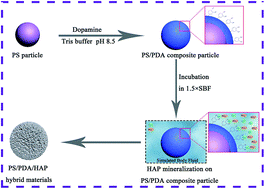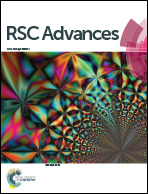Polydopamine-functionalized polymer particles as templates for mineralization of hydroxyapatite: biomimetic and in vitro bioactivity†
Abstract
The use of polymer particles as organic templates for producing inorganic materials is an intriguing approach, because it offers the synthetic feasibility of organic–inorganic hybrid materials which may promise a variety of interesting applications. Here, inspired by mussel-adhesion phenomena in nature, we combined the use of the active surface of polydopamine (PDA) with biomimetic mineralization of hydroxyapatite (HAP) to synthesize a novel HAP-based, organic–inorganic hybrid material. Monodisperse micro-sized polystyrene (PS) particles were first prepared as inert polymer templates via dispersion polymerization, which, subsequently, were coated with PDA through the self-polymerization of dopamine in a weakly alkaline aqueous environment (pH = 8.5). This chemical modification activated the inert surface of PS particles to become bioactive. Thus, these synthesized PS/PDA composite particles were ideal templates for the biomimetic mineralization of HAP when they were incubated in a simulated body fluid (SBF) solution in aid of the biocompatible PDA layer. During the PDA-assisted biomimetic mineralization, the PDA layer interacted with the mineral ions introduced, and anchored the mineralization of HAP exclusively onto the surfaces of the composite particles. The detailed structures and morphologies of HAP-based hybrid materials (PS/PDA/HAP hybrid materials) were characterized. These HAP-based hybrid materials did not show a significant in vitro cytotoxicity against HeLa cells, indicating their potential biocapacity for drug delivery, protein and gene transfer, and as coating materials for bioimplants or as the injectable scaffold materials in bone tissue engineering for defect filling and regeneration.


 Please wait while we load your content...
Please wait while we load your content...